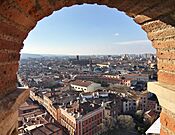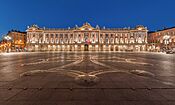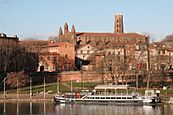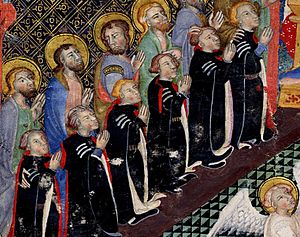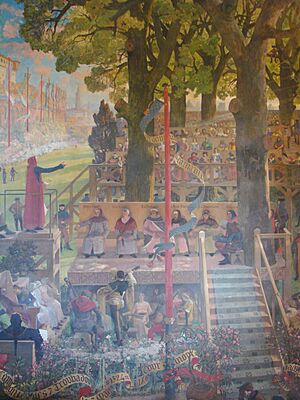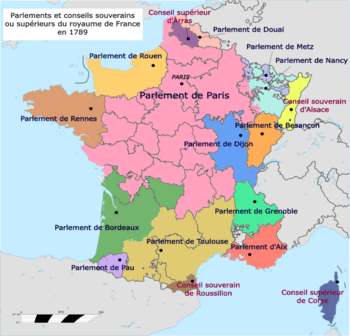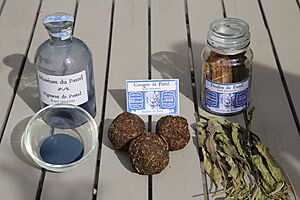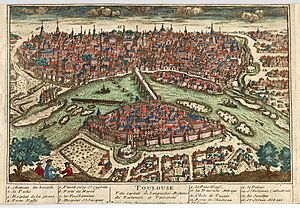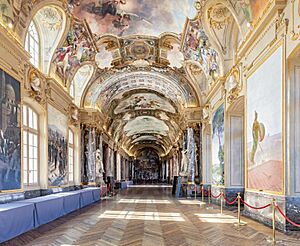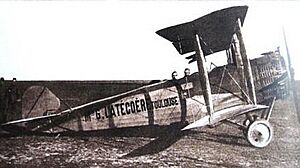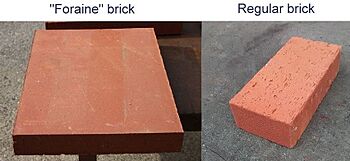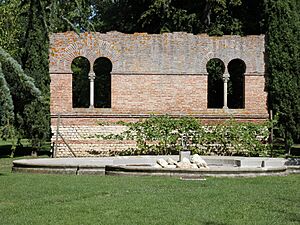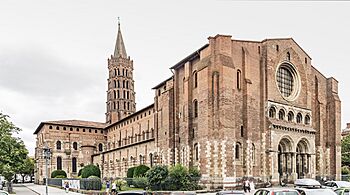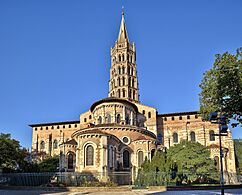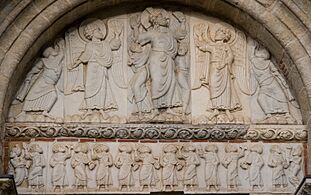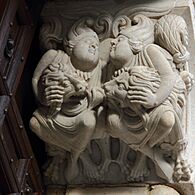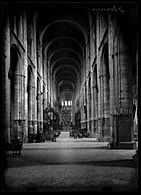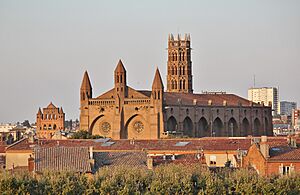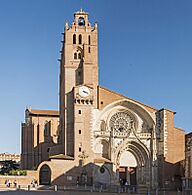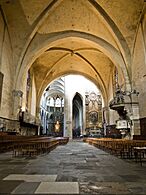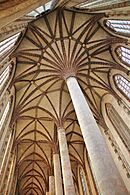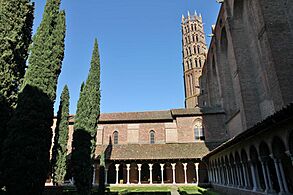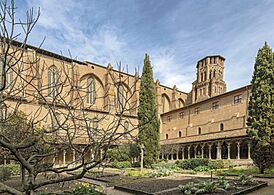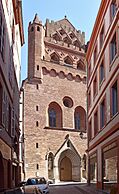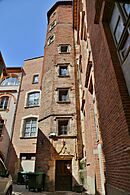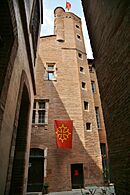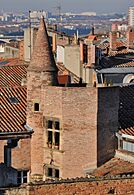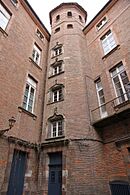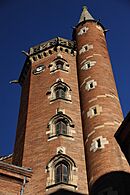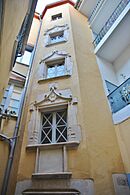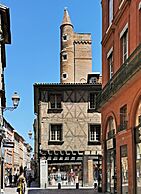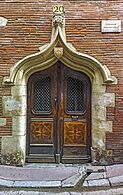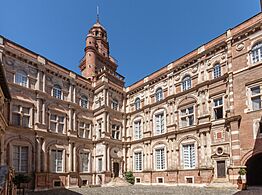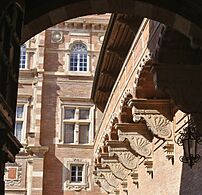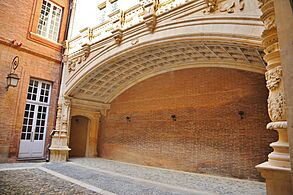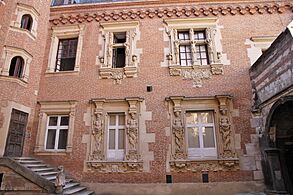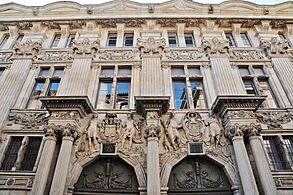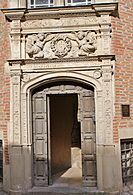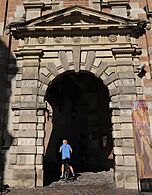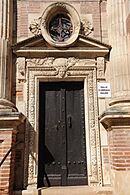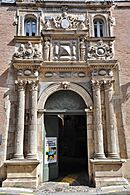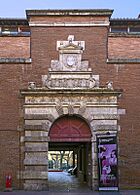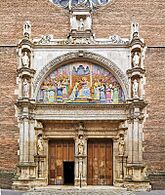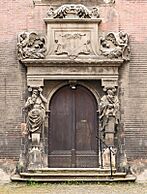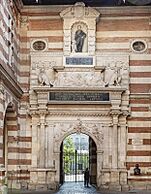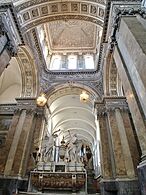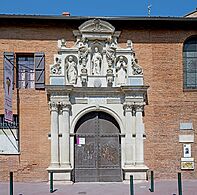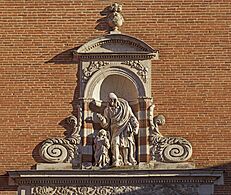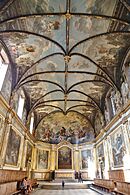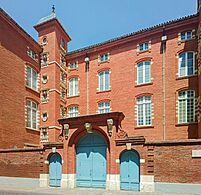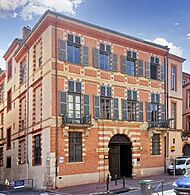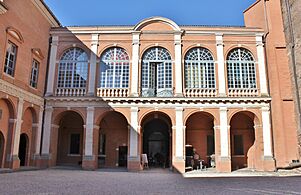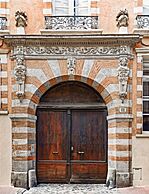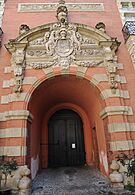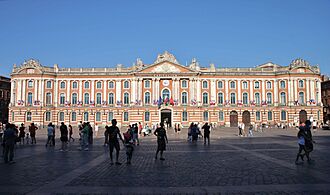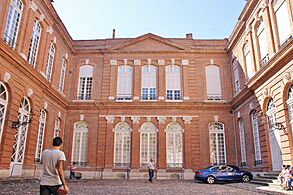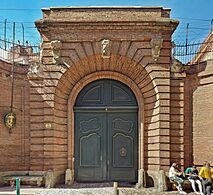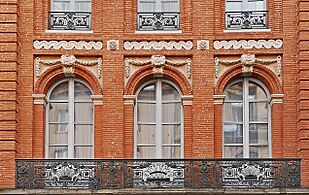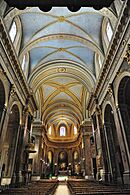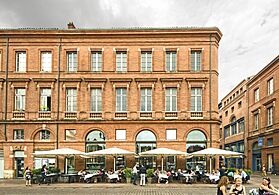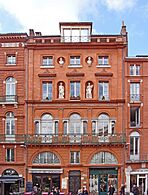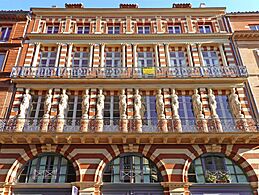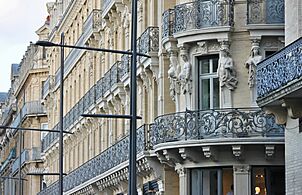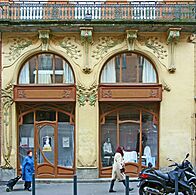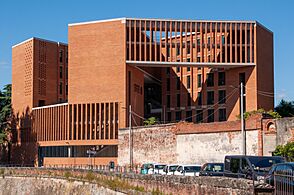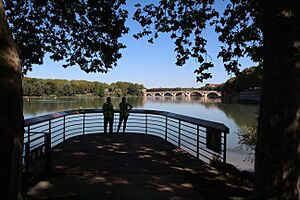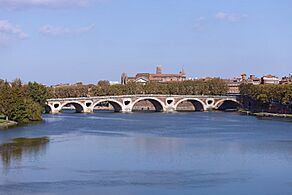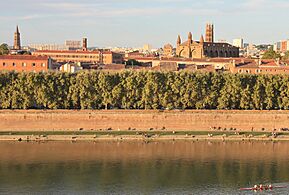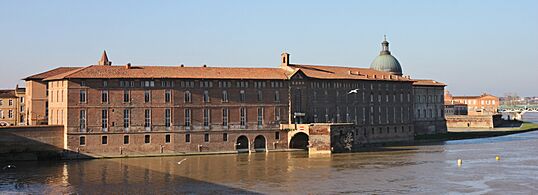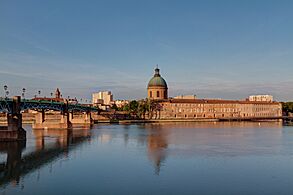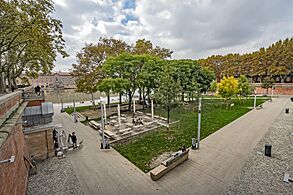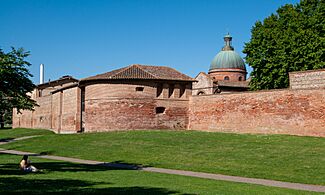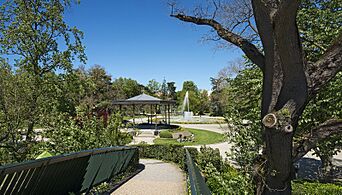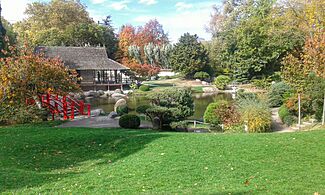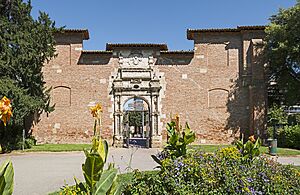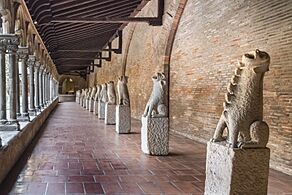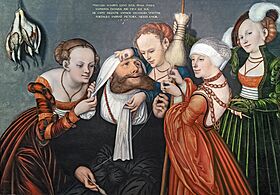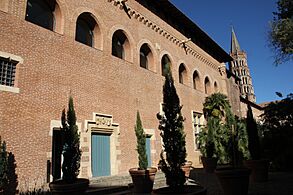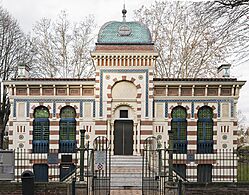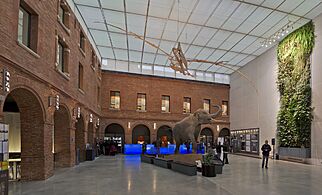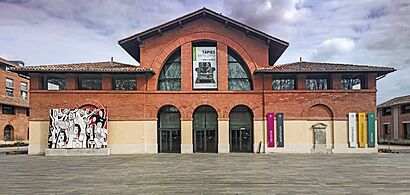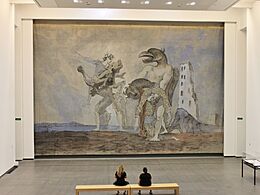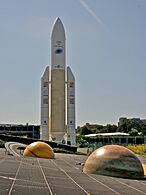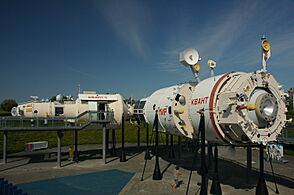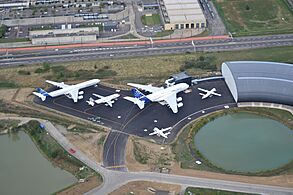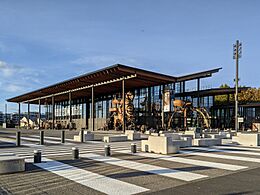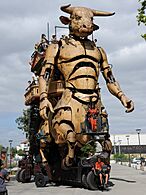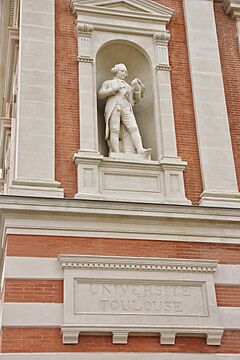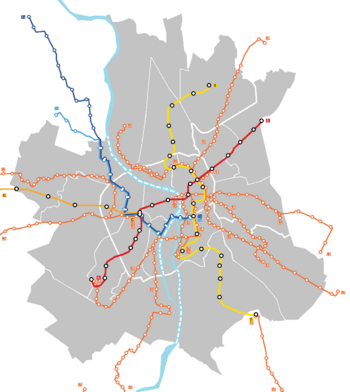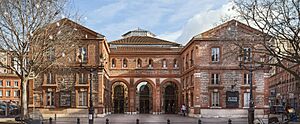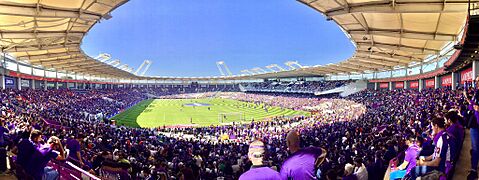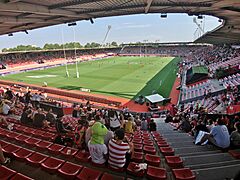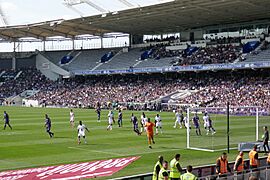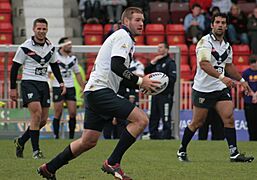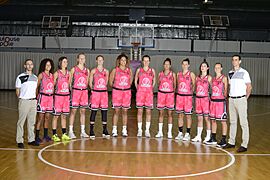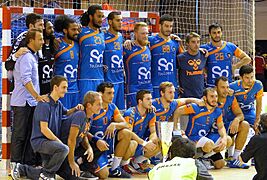Toulouse facts for kids
Quick facts for kids
Toulouse
Tolosa (Occitan)
|
|||
|---|---|---|---|
|
Prefecture and commune
|
|||
|
View of Old Toulouse
Ariane 5 (Cité de l'espace)
Place du Capitole
the first Airbus A380
Musée des Augustins
Hôtel d'Assézat
Church of the Jacobins
|
|||
|
|||
| Motto(s): | |||
| Country | France | ||
| Region | Occitanie | ||
| Department | Haute-Garonne | ||
| Arrondissement | Toulouse | ||
| Canton | (11 cantons) Toulouse-1, 2, 3, 4, 5, 6, 7, 8, 9, 10 and 11 | ||
| Intercommunality | Toulouse Métropole | ||
| Area
1
|
118.3 km2 (45.7 sq mi) | ||
| • Urban
(2020)
|
957.5 km2 (369.7 sq mi) | ||
| • Metro
(2020)
|
6,520.2 km2 (2,517.5 sq mi) | ||
| Population
(2021)
|
504,078 | ||
| • Rank | 4th in France | ||
| • Density | 4,261.0/km2 (11,036/sq mi) | ||
| • Urban
(2021)
|
1,063,235 | ||
| • Urban density | 1,110.43/km2 (2,876.00/sq mi) | ||
| • Metro
(2021)
|
1,490,640 | ||
| • Metro density | 228.6188/km2 (592.120/sq mi) | ||
| Demonym(s) | English: Toulousian French: Toulousain(e) Occitan: tolosenc(a) |
||
| Time zone | UTC+01:00 (CET) | ||
| • Summer (DST) | UTC+02:00 (CEST) | ||
| INSEE/Postal code |
31555 /
|
||
| 1 French Land Register data, which excludes lakes, ponds, glaciers > 1 km2 (0.386 sq mi or 247 acres) and river estuaries. | |||
Toulouse is a large city in the south of France. It is the capital of the Occitania region. The city sits on the River Garonne. It is about 150 kilometers from the Mediterranean Sea. Toulouse is the fourth-largest city in France. Around 504,078 people live in the city itself (2021). Its wider metropolitan area has about 1.5 million people.
Toulouse is a major center for the European aerospace industry. Big companies like Airbus have their main offices here. The Toulouse Space Centre (CST) is also in Toulouse. It is the largest national space center in Europe. Many other aerospace companies are also located here.
The flight route between Toulouse–Blagnac and Parisian airports is the busiest in France. Toulouse is known as a very active and growing city in France.
The Romans first founded Toulouse. In the 5th century, it was the capital of the Visigothic Kingdom. Later, it became the capital of the Languedoc province. Today, it is the unofficial capital of the Occitania cultural region.
The University of Toulouse was founded in 1229, making it one of Europe's oldest universities. Toulouse also has many top schools for aerospace engineering. It is the fourth-largest student city in France, with nearly 140,000 students.
Toulouse has three UNESCO World Heritage Sites. These include the Canal du Midi and the Basilica of St. Sernin. The Basilica is the largest Romanesque building still standing in Europe. It is part of the Santiago de Compostela pilgrimage route. The city's unique pink brick buildings have given it the nickname La Ville rose ("The Pink City").
Contents
- Exploring Toulouse's Geography
- Toulouse Through Time: A City's History
- Toulouse Population: Growth and Diversity
- Toulouse's Amazing Sights and Architecture
- Romanesque Architecture: Buildings from the 11th and 12th Centuries
- Gothic Architecture: From the 13th to Early 16th Century
- Renaissance Architecture: A Golden Age of Design (16th to Early 17th Century)
- 17th Century Architecture: New Styles and Buildings
- 18th Century Architecture: Grand Designs and Whitewash
- 19th Century Architecture: Modernizing the City
- 20th and 21st Centuries Architecture: Blending Old and New
- Garonne Riverbanks, Canal du Midi, and Parks
- Museums and Theme Parks: Learning and Fun
- Toulouse Economy: A Hub of High-Tech Industries
- Education in Toulouse: A City of Students
- Getting Around Toulouse: Transport Options
- Train Travel: Connecting the City and Beyond
- Metro System: Fast and Automatic Trains
- Tramway: Connecting Neighborhoods and the Airport
- Cable Car: A New Way to See the City
- Bicycle Rentals: Cycling Around Toulouse
- Airports: Flying In and Out of Toulouse
- Canal: Waterway to the Mediterranean
- Public Transport Statistics: How People Commute
- Communications: Connecting Toulouse
- Culture in Toulouse: Arts, Music, and Food
- Sports in Toulouse: Rugby, Football, and More
- Notable People from Toulouse: Famous Faces
- Toulouse's International Connections
- See also
Exploring Toulouse's Geography
Toulouse is located in southern France. It is north of the Haute-Garonne department. The city is on an important route between the Mediterranean Sea and the Atlantic Ocean. The Pyrenees mountains and the borders with Andorra and Spain are about 100 kilometers away.

Rivers and Canals: Waterways of Toulouse
Several waterways flow through Toulouse. These include the Canal de Brienne, the Canal du Midi, and the Canal de Garonne. The city also has the Garonne, Touch, and Hers-Mort rivers.

Toulouse Climate: Understanding the Weather
Toulouse has a four-season humid subtropical climate. This means it has warm, humid summers and mild winters. It gets enough rain throughout the year.
| Climate data for Toulouse (TLS), elevation: 151 m (495 ft), 1991–2020 normals, extremes 1947–present | |||||||||||||
|---|---|---|---|---|---|---|---|---|---|---|---|---|---|
| Month | Jan | Feb | Mar | Apr | May | Jun | Jul | Aug | Sep | Oct | Nov | Dec | Year |
| Record high °C (°F) | 21.2 (70.2) |
24.1 (75.4) |
27.1 (80.8) |
30.0 (86.0) |
34.4 (93.9) |
40.2 (104.4) |
40.2 (104.4) |
42.4 (108.3) |
35.3 (95.5) |
31.8 (89.2) |
24.3 (75.7) |
21.1 (70.0) |
42.4 (108.3) |
| Mean daily maximum °C (°F) | 9.7 (49.5) |
11.2 (52.2) |
15.0 (59.0) |
17.6 (63.7) |
21.4 (70.5) |
25.7 (78.3) |
28.2 (82.8) |
28.5 (83.3) |
24.8 (76.6) |
19.7 (67.5) |
13.5 (56.3) |
10.4 (50.7) |
18.8 (65.8) |
| Daily mean °C (°F) | 6.3 (43.3) |
7.1 (44.8) |
10.3 (50.5) |
12.7 (54.9) |
16.4 (61.5) |
20.3 (68.5) |
22.6 (72.7) |
22.8 (73.0) |
19.3 (66.7) |
15.3 (59.5) |
9.9 (49.8) |
7.0 (44.6) |
14.2 (57.6) |
| Mean daily minimum °C (°F) | 2.9 (37.2) |
3.1 (37.6) |
5.5 (41.9) |
7.9 (46.2) |
11.4 (52.5) |
15.0 (59.0) |
17.0 (62.6) |
17.1 (62.8) |
13.9 (57.0) |
10.9 (51.6) |
6.3 (43.3) |
3.6 (38.5) |
9.6 (49.3) |
| Record low °C (°F) | −18.6 (−1.5) |
−19.2 (−2.6) |
−8.4 (16.9) |
−3.0 (26.6) |
−0.8 (30.6) |
4.0 (39.2) |
7.6 (45.7) |
5.5 (41.9) |
1.9 (35.4) |
−3.0 (26.6) |
−7.5 (18.5) |
−12.0 (10.4) |
−19.2 (−2.6) |
| Average precipitation mm (inches) | 52.5 (2.07) |
37.2 (1.46) |
45.3 (1.78) |
65.2 (2.57) |
73.6 (2.90) |
64.2 (2.53) |
40.1 (1.58) |
44.6 (1.76) |
45.7 (1.80) |
54.3 (2.14) |
55.0 (2.17) |
49.3 (1.94) |
627.0 (24.69) |
| Average precipitation days (≥ 1.0 mm) | 9.2 | 7.8 | 8.2 | 9.3 | 9.9 | 7.1 | 5.7 | 5.9 | 6.6 | 7.5 | 10.0 | 8.7 | 95.8 |
| Average snowy days | 1.8 | 2.0 | 0.5 | 0.3 | 0.0 | 0.0 | 0.0 | 0.0 | 0.0 | 0.0 | 0.5 | 1.2 | 6.1 |
| Average relative humidity (%) | 87 | 82 | 77 | 76 | 76 | 72 | 68 | 71 | 74 | 81 | 85 | 88 | 78 |
| Mean monthly sunshine hours | 89.1 | 118.2 | 175.3 | 188.5 | 212.3 | 231.8 | 258.6 | 246.4 | 210.1 | 155.2 | 99.9 | 89.7 | 2,075.1 |
| Source 1: Meteo France | |||||||||||||
| Source 2: Infoclimat.fr (relative humidity 1961–1990) | |||||||||||||
| Climate data for Toulouse–Francazal, elevation: 164 m (538 ft), 1991–2020 normals, extremes 1922–present | |||||||||||||
|---|---|---|---|---|---|---|---|---|---|---|---|---|---|
| Month | Jan | Feb | Mar | Apr | May | Jun | Jul | Aug | Sep | Oct | Nov | Dec | Year |
| Record high °C (°F) | 23.3 (73.9) |
24.8 (76.6) |
28.3 (82.9) |
29.9 (85.8) |
33.9 (93.0) |
39.6 (103.3) |
40.2 (104.4) |
44.0 (111.2) |
36.0 (96.8) |
35.4 (95.7) |
27.0 (80.6) |
26.9 (80.4) |
44.0 (111.2) |
| Mean daily maximum °C (°F) | 9.9 (49.8) |
11.3 (52.3) |
15.0 (59.0) |
17.6 (63.7) |
21.3 (70.3) |
25.5 (77.9) |
28.1 (82.6) |
28.6 (83.5) |
24.8 (76.6) |
19.8 (67.6) |
13.7 (56.7) |
10.7 (51.3) |
18.9 (66.0) |
| Daily mean °C (°F) | 6.5 (43.7) |
7.3 (45.1) |
10.3 (50.5) |
12.8 (55.0) |
16.5 (61.7) |
20.3 (68.5) |
22.6 (72.7) |
22.8 (73.0) |
19.4 (66.9) |
15.4 (59.7) |
10.0 (50.0) |
7.2 (45.0) |
14.3 (57.7) |
| Mean daily minimum °C (°F) | 3.1 (37.6) |
3.2 (37.8) |
5.7 (42.3) |
8.0 (46.4) |
11.6 (52.9) |
15.1 (59.2) |
17.0 (62.6) |
17.1 (62.8) |
13.9 (57.0) |
11.0 (51.8) |
6.4 (43.5) |
3.8 (38.8) |
9.7 (49.5) |
| Record low °C (°F) | −19.0 (−2.2) |
−16.7 (1.9) |
−7.4 (18.7) |
−4.1 (24.6) |
0.1 (32.2) |
4.5 (40.1) |
7.0 (44.6) |
7.3 (45.1) |
0.0 (32.0) |
−2.6 (27.3) |
−8.5 (16.7) |
−13.4 (7.9) |
−19.0 (−2.2) |
| Average precipitation mm (inches) | 56.4 (2.22) |
38.8 (1.53) |
43.7 (1.72) |
65.2 (2.57) |
74.7 (2.94) |
59.2 (2.33) |
42.5 (1.67) |
42.6 (1.68) |
50.5 (1.99) |
52.4 (2.06) |
58.2 (2.29) |
51.5 (2.03) |
635.7 (25.03) |
| Average precipitation days (≥ 1.0 mm) | 8.8 | 7.6 | 8.1 | 9.5 | 9.5 | 7.1 | 5.6 | 6.0 | 6.4 | 7.7 | 9.6 | 9.0 | 94.8 |
| Mean monthly sunshine hours | 93.1 | 116.6 | 173.6 | 186.7 | 207.5 | 224.8 | 246.8 | 234.9 | 202.5 | 147.9 | 94.9 | 85.4 | 2,014.5 |
| Source: Meteo France (sun 1991–2010) | |||||||||||||
Toulouse Through Time: A City's History
Toulouse has a long and interesting history. The area around the Garonne Valley was important for trade even in the Iron Age.
Early History: From Roman Outpost to Visigothic Capital
The city's old name, Tolosa, appeared in the 2nd century BC. It might come from ancient languages or mean "little hill."
How the Romans Shaped Toulouse
In the 2nd century BC, Tolosa became a Roman military base. After the Romans conquered Gaul, they developed it into a city. Emperor Augustus moved the city closer to the Garonne River. This was better for trade.
Around 250 AD, Saturnin, the first bishop of Toulouse, was martyred. This shows how hard it was for Christianity to start in Roman Gaul.
Toulouse as Capital of the Visigoths
In the 5th century, Toulouse became part of the Visigothic kingdom. It was a very important city, even serving as its capital. In 507, the Franks took over the city. After this, Toulouse became the capital of Aquitaine within the Frankish kingdom.
Under Frankish Rule: Battles and Beginnings
In 721, Duke Odo of Aquitaine defeated a Muslim army at the Battle of Toulouse. Many historians believe this victory stopped Muslim expansion into Christian Europe.
Later, a County of Toulouse grew within the Frankish kingdom. The Battle of Toulouse of 844 was a key event in the Frankish Civil War.
County of Toulouse: A Time of Independence and Change

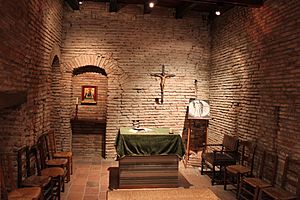

Charlemagne created the County of Toulouse in 778 to protect the border with Muslim Spain. Over time, the county became largely independent.
In the 11th and 12th centuries, southern France had a strong Latin culture. Unlike northern France, it followed Roman law. Nobles were well-educated. This was the time of the troubadours, poets who wrote in Occitan. Counts of Toulouse supported these poets.
In 1096, Raymond IV, Count of Toulouse, joined the First Crusade. He was one of its main leaders. This weakened the city's military power. In 1152, Toulouse gained more self-rule. Its leaders, called capitouls, began to run the city. The Bazacle Milling Company in Toulouse was the first recorded European joint-stock company.
The Albigensian Crusade and Its Impact
In the early 13th century, the County of Toulouse faced the Albigensian Crusade. This crusade lasted 20 years (1209-1229). Its goal was to stop Catharism, a religious movement in southern France.
After many battles, King Louis VIII of France intervened. This led to the end of the County of Toulouse's independence. It became part of the French Crown.
This struggle had several important effects on Toulouse:
- The Dominican Order was founded in Toulouse in 1215 by Saint Dominic. He wanted to convert Cathars peacefully.
- A new, simpler architectural style, the Southern French Gothic, began in Toulouse. It aimed to show less luxury than other Catholic churches.
- The Treaty of Paris of 1229 officially made Toulouse part of France.
- The University of Toulouse was created in 1229. It was meant to help stop the Cathar movement.
- The Council of Toulouse in 1229 set up the Inquisition. This aimed to remove Catharism from the region.
Toulouse in the Kingdom of France
In 1271, Toulouse became part of the French royal domain. This led to new leaders and more trade. By 1298, rich merchants often became capitouls.
The early 14th century was a good time for Toulouse. In 1335, it had between 35,000 and 40,000 people.
In 1323, the Consistori del Gay Saber was created. This group aimed to keep the art of the troubadours alive through poetry contests. It is the oldest literary society in Europe. It later became the Royal Academy of the Floral Games.
The Black Death in 1348 and the Hundred Years' War caused problems. Toulouse's population dropped to 19,000 by 1405. Despite this, Toulouse was a key French stronghold during the war.
In 1369, the bones of Saint Thomas Aquinas were moved to the Jacobins of Toulouse. This honored the city as the birthplace of the Dominican order.
Things improved by the mid-15th century. In 1443, King Charles VII created the second parliament of France. This made Toulouse an important legal center. The city grew richer from trade in wine, grains, and textiles. A big source of income was pastel, a blue dye from woad.
Toulouse had several fires. The Great Fire of Toulouse in 1463 lasted 15 days. After this, King Louis XIII removed taxes for 100 years. The city leaders made rules to use brick instead of wood for buildings.
The 16th century was a golden age for Toulouse's economy. Its Parliament made it a judicial capital. It was the main European center for woad trade. The city's wealth led to beautiful Renaissance mansions. By 1550, Toulouse was one of France's largest cities, with about 50,000 people.
In 1562, the French Wars of Religion began. Toulouse became a strong Catholic city in a Protestant area. This ended its economic boom.
In 1666, Pierre-Paul Riquet started building the Canal du Midi. This canal connects Toulouse to the Mediterranean Sea. It helped Toulouse's economy by making it easier to trade goods.
In the 18th century, Toulouse was a proud provincial capital. However, it was sometimes behind new ideas. For example, in 1762, its powerful parliament sentenced Jean Calas to death. The philosopher Voltaire said this was religious intolerance. Voltaire's actions damaged the parliament's reputation.
The French Revolution in 1789 changed everything. Toulouse lost much of its power. It went from being the capital of a large province to just the head of the small Haute-Garonne department.
19th Century: Modernization and Challenges
On April 10, 1814, the Battle of Toulouse took place. This was one of the last battles between French and British forces on French soil.
Unlike many French cities, Toulouse did not have a big industrial revolution in the 19th century. Its main industries were gunpowder and tobacco. In 1856, the railway arrived. The city modernized, replacing old walls with wide boulevards.
In 1875, a flood of the Garonne River destroyed over 1,000 houses and killed 200 people. Only the Pont-Neuf survived.
20th and 21st Centuries: Aerospace and Growth
World War I brought chemical and aviation industries to Toulouse. This started the city's tradition in aircraft building. After the war, the famous Aéropostale airmail company was based here. Famous pilots like Antoine de Saint-Exupéry worked for it.
In the 1920s and 1930s, Toulouse's population grew. Many Italians and Spaniards came, fleeing difficult situations in their home countries. In the 1960s, French people returning from Algeria also moved to the city.
In 1963, Toulouse was chosen to become a "balancing Metropolis." This helped it regain its importance among France's major cities. The French government encouraged the city to focus on aerospace and space activities. These industries grew quickly, boosting Toulouse's economy and population.
On September 21, 2001, an explosion happened at the AZF fertilizer factory. It caused 31 deaths and many injuries. The blast was felt far away.
In 2016, a new regional plan made Toulouse the capital of the Occitanie region. This gave it a role that matches its past as a major French capital.
Toulouse Population: Growth and Diversity
| Historical population | ||||
|---|---|---|---|---|
| Urban Area | Metropolitan Area |
|||
| 1695 | 43,000 | |||
| 1750 | 48,000 | |||
| 1790 | 52,863 | |||
| 1801 | 50,171 | |||
| 1831 | 59,630 | |||
| 1851 | 95,277 | |||
| 1872 | 126,936 | |||
| 1911 | 149,000 | |||
| 1936 | 213,220 | |||
| 1946 | 264,411 | |||
| 1954 | 268,865 | |||
| 1962 | 329,044 | |||
| 1968 | 489,293 | 687,804 | ||
| 1975 | 570,217 | 776,960 | ||
| 1982 | 601,576 | 827,714 | ||
| 1990 | 683,436 | 935,009 | ||
| 1999 | 782,296 | 1,062,974 | ||
| 2007 | 888,479 | 1,235,746 | ||
| 2012 | 940,016 | 1,322,271 | ||
| 2017 | 1,004,747 | 1,414,936 | ||
| 2021 | 1,063,235 | 1,490,640 | ||
In January 2020, the city of Toulouse had 498,003 people. Its wider metropolitan area had 1,470,899 people. This was an increase from 1,268,438 in January 2009. Toulouse's metropolitan area grew by 1.36% per year between 2009 and 2020. This was one of the fastest growth rates among large French cities.
Toulouse is the fourth most populated city in France. It is behind Paris, Marseille, and Lyon. Its metropolitan area is the fifth most populated.
The population of the Toulouse metropolitan area grew by 57.3% between 1990 and 2020. This was due to the booming aerospace and high-tech industries. This growth rate was much higher than the average for France.
Toulouse is a diverse city. A local Jewish group estimates about 2,500 Jewish families live there. A Muslim association estimates about 35,000 Muslims live in the city.
Immigration: People from Around the World
| Country of birth | Population (2020) |
|---|---|
| 14,152 | |
| 11,887 | |
| 5,542 | |
| 3,943 | |
| 2,983 | |
| 2,386 | |
| 1,415 | |
| 1,348 | |
| 1,346 | |
| 1,198 |
Toulouse's Amazing Sights and Architecture
Toulouse is known as a "City of Art and History." It has a rich architectural heritage. This includes Romanesque and Gothic churches. It also has grand Renaissance mansions. Most of its old buildings are in the city's inner area.
Almost all historical buildings are made from "foraine" brick. This traditional brick gives Toulouse its nickname, Ville rose (Pink City). "Foraine" bricks are large, flat, and range from orange-pink to red.
White stone was rare and expensive in Toulouse. It had to be brought from the Pyrenees by river. This mix of red brick and white stone gives Toulouse its unique look.
Romanesque Architecture: Buildings from the 11th and 12th Centuries
Toulouse's Romanesque architecture is famous for the Basilica of Saint-Sernin. This church is one of Europe's most important Romanesque buildings. It has kept its original Romanesque style.
Basilica of Saint-Sernin: A Pilgrim's Stop
The Basilica of Saint-Sernin is a UNESCO World Heritage Site. It was a major pilgrimage site. It is one of the two largest Romanesque churches still standing in Europe. The church holds over 200 relics. Many were given by Charlemagne.
The church was built in the late 11th and early 12th centuries. It was designed to welcome many pilgrims. Its layout allowed pilgrims to walk around the church. They could stop at chapels for prayer. The church is also known for its beautiful Romanesque sculptures.
- Basilica of Saint-Sernin
Gothic Architecture: From the 13th to Early 16th Century
Southern French Gothic: A Unique Religious Style
In the early 13th century, a new, simpler style of church building began in Toulouse. It was called Southern French Gothic. This style aimed to be less luxurious. It brought people together in large, open naves for preaching. This style spread to many churches in the region.
Two important examples of this style in Toulouse are:
- Cathedral of Saint-Étienne: This cathedral shows the city's history. Its wide single nave is an early example of Southern French Gothic. The higher choir was built in a different Gothic style after Toulouse became part of France.
- Convent of the Jacobins: This was a Dominican convent. It is considered a top example of Southern French Gothic. Its outside is simple. But inside, tall columns create a stunning space. The column closing the choir is shaped like a palm tree. In 1368, Pope Urban V made this church the burial place of Saint Thomas Aquinas.
- Southern French Gothic religious architecture
Gothic Civil Architecture: Towers and Mansions
Toulouse has about 30 Gothic stair towers. These are parts of old private mansions (called hôtels particuliers). Many are hidden in courtyards. Some towers are very tall, showing the wealth of their owners.
Most houses in Toulouse were made of wood back then. So, these brick towers and mansions show their high quality.
- Gothic civil architecture
Renaissance Architecture: A Golden Age of Design (16th to Early 17th Century)
The 16th century was a golden age for Toulouse. The woad trade made many merchants rich. The Parlement of Toulouse made the city a legal center. These wealthy people built amazing private mansions. Their designs were inspired by famous architects and royal castles.
These Renaissance mansions were built over a century (around 1515–1620). Famous architects like Louis Privat and Nicolas Bachelier designed them. Some of the most well-known are the Assézat, Bernuy, and Vieux-Raisin.
- Renaissance private mansions
- Sample of Renaissance doors
17th Century Architecture: New Styles and Buildings
17th Century Religious Buildings
The French Wars of Religion brought many religious groups to Toulouse. They built Baroque churches in the 17th century. Examples include the church of Saint-Pierre des Chartreux and the church of Saint-Exupère. The Chapel of the Carmelites is also known for its painted decoration.
- 17th c. religious architecture
17th Century Civil Buildings
After the Renaissance, civil buildings became less decorated. The focus shifted to simpler structures and interior designs. Playing with colors (brick and stone) and textures (bossing) was a cheaper way to make facades interesting. Many private mansions from this century were built by members of parliament.
- 17th c. civil architecture
-
Hôtel Saint-Jean (courtyard), former Grand Priory of Knights Hospitaller
18th Century Architecture: Grand Designs and Whitewash
In the 18th century, Toulouse thrived on its Parliament and grain trade. The Canal du Midi helped boost this trade. Major projects included building the Garonne quays and the new facade of the Capitole. Architect Guillaume Cammas designed the Capitole facade (1750-1760).
Later in the 18th century, white paint became popular. Buildings were whitewashed to look like stone. Today, you can still see walls with grooves carved in brick. These grooves were made to imitate stone blocks.
- 18th century architecture
19th Century Architecture: Modernizing the City
Toulouse's 19th-century architecture has three main phases. In the first half, architect Jacques-Pascal Virebent created unified squares. These include the Place du Capitole and Place Wilson. Their uniform style was inspired by Paris.
From 1830, Auguste Virebent and his brothers created molded decorations. These low-cost terracotta ornaments decorated many Toulouse facades.
Later in the century, large avenues were opened in the city center. Alsace-Lorraine street, for example, was built with yellow brick. This was to imitate Parisian stone buildings.
- 19th century architecture
20th and 21st Centuries Architecture: Blending Old and New
In the mid-19th century, the railway made stone cheaper. Architects started using stone more often. The main railway station, built in 1905, is entirely made of white stone.
Later, concrete became common. However, brick and stone are still used for outer layers. Modern architects like Robert Venturi and Shelley McNamara have used them. Their work includes the departmental council seat and the Toulouse School of Economics building.
- 20th and 21st centuries architecture
Garonne Riverbanks, Canal du Midi, and Parks
The Garonne river banks offer great views of the city. Red brick dykes from the 18th century protect the city from floods. The Pont-Neuf took almost a century to build (1545-1632). It was very modern for its time. It was the only bridge in Toulouse to survive past floods.
The Bazacle is a shallow crossing point on the Garonne. In the 12th century, the Bazacle Milling Company was the first recorded European joint-stock company. On the left bank of the river are two former hospitals. These are the Hôtel-Dieu Saint-Jacques and the Hôpital de La Grave. They were built to keep sick people away from the city.
The Canal du Midi, built in the late 17th century, goes around the city center. It connects Toulouse to the Mediterranean Sea. Its 240 kilometers were made a UNESCO World Heritage Site in 1996.
Toulouse has many parks. The Jardin des Plantes, Grand Rond, and Jardin Royal are connected. They include a natural history museum, cafes, and a botanical garden. Other nice parks are the Prairie des Filtres and the Japanese garden.
- Banks of the Garonne, Canal du Midi, parks
-
Raymond VI garden, with remains of old ramparts.
-
Canal du Midi (17th c.).
Museums and Theme Parks: Learning and Fun
Toulouse has many museums. Some of the most important are:
- Musée des Augustins: This is Toulouse's fine arts museum. It is in an old Augustinian convent.
- Bemberg Foundation: Located in the Hôtel d'Assézat, it has a major private art collection.
- Musée Saint-Raymond: This is Toulouse's archeological museum. It shows the ancient history of Toulouse. It has Roman sculptures.
- Musée Paul Dupuy: This museum focuses on Decorative Arts and Graphic Arts. It has a large collection of clocks.
- Musée Georges Labit: This museum has artifacts from East Asia and Ancient Egypt.
- Muséum de Toulouse: One of France's most important natural history museums.
- Les Abattoirs: This is the city's modern and contemporary art museum. It is in a former slaughterhouse.
- Museums
Toulouse also has theme parks, especially about aviation and space:
- Cité de l'espace: A science center focused on space travel.
- Aeroscopia: An aviation theme park near Toulouse–Blagnac Airport. It preserves historical aircraft, like two Concorde airliners.
- L'Envol des pionniers: A museum about l'Aéropostale. This was a pioneering airmail company. It operated between France and South America. Famous pilots like Antoine de Saint-Exupéry worked there.
- Halle de La Machine: A large hall with many animated machines. These are often inspired by aviation and human adventures.
- Theme parks
Toulouse Economy: A Hub of High-Tech Industries
Since 2003, Toulouse has had the fastest growing economy per person in France. This is thanks to its growing high-tech industries.
Toulouse's economy relies on three main things. These are large industrial companies, research labs, and many students and scientists. Toulouse has the second largest research and education center in France. It has excellent engineering schools. World leaders like Airbus and Thales Alenia support its industries. This environment helps new ideas grow in fields like artificial intelligence and space technology.
Toulouse is known as the 'capital' of the European aerospace industry. It has the main offices and assembly lines for Airbus planes. These include the A320, A330, and A350. The A380 was also built here. Toulouse also hosts the headquarters of ATR. For the space industry, Toulouse is the main European hub. It has 12,000 jobs and 400 companies in this field.
Education in Toulouse: A City of Students
Toulouse has the fourth-largest student population in France. It has 103,000 students (2012). Only Paris, Lyon, and Lille have more.
Colleges and Universities: Learning and Research

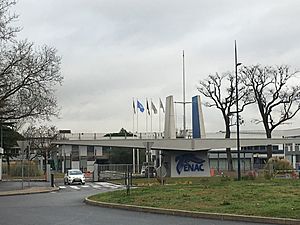
The University of Toulouse was founded in 1229. It is now split into three separate universities. Like Oxford and Paris, it was created when Europeans were translating ancient writings. These writings led to new scientific discoveries and art. The Church supported these colleges.
Toulouse is also home to many business and engineering schools:
- Toulouse Business School (TBS)
- Toulouse School of Economics (TSE)
- ISAE SUPAERO (aerospace engineering)
- ENAC (civil aviation)
Primary and Secondary Schools: Local and International Options
The most famous high schools in Toulouse are Lycée Pierre-de-Fermat and Lycée Saint-Sernin.
For international students, there are schools in nearby Colomiers:
- International School of Toulouse
- Deutsche Schule Toulouse (German school)
Getting Around Toulouse: Transport Options
Train Travel: Connecting the City and Beyond
The main train station is Toulouse-Matabiau station. It has regional and national services. There are also smaller stations within the city.
Metro System: Fast and Automatic Trains
All public transport (bus, metro, tram) is run by Tisséo. The Toulouse Metro is a driverless system.
- Line A runs for 12.5 kilometers from north-east to south-west.
- Line B opened in 2007. It has 20 stations from north to south. It connects with Line A at Jean Jaurès.
Line C is being built and will open in 2028. It will have 21 stations over 27km. It will connect to Line B and Line A. The old Line C was a local train service. It is now called Arènes-Colomiers train line.
Line D runs south from Toulouse Matabiau to Muret.
Tramway: Connecting Neighborhoods and the Airport
Toulouse has two tram lines:
- Tramway line T1 has 25 stations and is 14.8km long. It connects Toulouse to the MEETT Exhibition Centre.
- Tramway line T2 connects to Toulouse-Blagnac airport. It is being changed into an express tram. It will connect to metro line C in 2028.
Cable Car: A New Way to See the City
Since May 13, 2022, Toulouse has a new public transport called Téléo. This is a cable car. It connects Paul-Sabatier University to Rangueil Hospital and the Oncopole. It flies over the Garonne River. At 3 kilometers, it is France's longest urban cable car. It is part of a plan to create a transport belt around southern Toulouse.
Bicycle Rentals: Cycling Around Toulouse
In 2007, a citywide bicycle rental program started. It is called VélôToulouse. You can rent bikes from automated stations.
Airports: Flying In and Out of Toulouse
Airports in Toulouse include:
- Toulouse Blagnac: The main local airport.
- Toulouse Francazal: An older airport, now with limited activity.
- Toulouse Lasbordes: For leisure flying and flying clubs.
Canal: Waterway to the Mediterranean
The Canal du Midi starts in Toulouse. It runs all the way to Sète.
Public Transport Statistics: How People Commute
On a weekday, people in Toulouse spend about 44 minutes using public transport. About 9.1% ride for more than 2 hours daily. The average wait time at a stop is 9 minutes. About 10.4% wait over 20 minutes. The average distance for a single trip is 7 kilometers.
Communications: Connecting Toulouse
Toulouse has the Bonhoure Radio Tower. It is 61 meters tall. It is used for FM and TV signals. In 2001, a 100-kilometer optical fiber network was built. It connects the city and its suburbs.
Culture in Toulouse: Arts, Music, and Food
The Théâtre du Capitole is where opera and ballet are performed. It has been a theater since 1736. The Orchestre National du Capitole plays at the Halle aux Grains. On October 31, 2023, Toulouse was named a UNESCO City of Music.
Le Château d'Eau is an old water-tower. It was turned into a photography gallery in 1974. It is one of the oldest public places for photography in the world. Toulouse has many art museums. These include the Musée des Augustins and the Musée des Abattoirs.
Toulouse is home to the Académie des Jeux Floraux. This group is like the French Academy for Occitan-speaking areas. This makes Toulouse the unofficial capital of Occitan culture. The traditional Cross of Toulouse is a symbol of the city.
The city's special foods include Saucisse de Toulouse, a type of sausage. Cassoulet Toulousain is a bean and pork stew. Garbure is a cabbage soup with poultry. Foie gras, from ducks or geese, is also a local delicacy.
Sports in Toulouse: Rugby, Football, and More
Stade Toulousain is a very successful rugby union club. They have won the European champions title six times. They have also won the French championship twenty-three times.
Toulouse Olympique plays rugby league. They have played in the British rugby league system since 2016. They were in the top tier Super League in 2022. They have won the French championship six times.
The city also has a professional football team, Toulouse FC. They play in Ligue 1, France's top football league. They won the Coupe de France in 2023. The team plays at the Stadium Municipal. This stadium was used for the 1998 FIFA World Cup and 2007 Rugby World Cup.
- Major sports facilities and professional clubs
-
Football: Toulouse Football Club.
Notable People from Toulouse: Famous Faces

Many famous people have come from Toulouse.
- Scientists include Jean Dausset (Nobel Prize in Medicine, 1980).
- Mathematician Pierre de Fermat (17th century) lived in Toulouse. He wrote Fermat's Last Theorem.
- Paul Sabatier (Nobel Prize in Chemistry, 1912).
- Albert Fert (Nobel Prize in Physics, 2007).
- Jean Tirole (Nobel Prize in Economic Sciences, 2014).
In music, Toulouse is one of the possible birthplaces of Carlos Gardel. He is a very important figure in tango music. The city's most famous songwriter is Claude Nougaro.
In arts, Toulouse is the birthplace of painter Henri Martin. Sculptors Alexandre Falguière and Antonin Mercié were also born here. Henri de Toulouse-Lautrec's family had ties to the Counts of Toulouse.
Other notable people include:
- Raymond IV, Count of Toulouse (a leader of the First Crusade).
- Aviation pioneer Clément Ader.
- Acrobatic performer Jules Léotard, who gave his name to the leotard.
- French football legend Just Fontaine.
Toulouse's International Connections
Twin Towns and Sister Cities: Global Friendships
Toulouse has special partnerships with other cities around the world. These are called twin towns or sister cities.
Other Cooperations: Working Together
Toulouse also works with other towns on different projects:
- Zaragoza, Aragón, Spain
- N'Djamena, Chad
- Hanoi, Vietnam
- Saint-Louis, Senegal
- Düsseldorf, Germany
- Kfardebian, Lebanon
See also
 In Spanish: Toulouse para niños
In Spanish: Toulouse para niños


